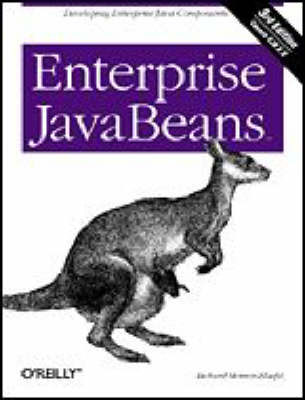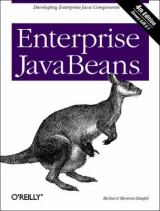
Enterprise JavaBeans
O'Reilly Media (Verlag)
978-0-596-00226-8 (ISBN)
- Titel erscheint in neuer Auflage
- Artikel merken
Message driven beans are a new kind of enterprise bean based on asynchronous messaging and the Java Message service (JMS). Instead of responding to Java RMI calls, message driven beans process JMS messages sent by messaging clients. An entire chapter is devoted to message-driven beans and how to use them effectively. In addition, the third edition contains an architecture overview, information on resource management and primary services, design strategies, and XML deployment descriptors.
Richard Monson-Haefel is one of the world's leading experts on Enterprise JavaBeans. He is the architect of OpenEJB, an open source EJB container, and has consulted as an architect on Enterprise JavaBeans, CORBA, Java RMI and other distributed computing projects over the past several years. Richard is the co-author of O'Reilly's Java Message Service, as well as author of numerous articles. He maintains jMiddleware.com , a website with resources and articles dedicated to the discussion of EJB, JMS, J2EE and other Java middleware technologies.
Preface. 1. Introduction Setting the Stage Enterprise JavaBeans Defined Distributed Object Architectures Component Models Component Transaction Monitors CTMs and Server-Side Component Models Titan Cruises: An Imaginary Business What's Next? 2. Architectural Overview The Enterprise Bean Component Using Enterprise Beans The Bean-Container Contract Summary. 3. Resource Management and the Primary Services Resource Management Primary Services What's Next? 4. Developing Your First Enterprise Beans Choosing and Setting Up an EJB Server Developing an Entity Bean Developing a Session Bean. 5. The Client View Locating Beans with JNDI The Remote Client API EJB 2.0: The Local Client API. 6. EJB 2.0 CMP: Basic Persistence Overview The Customer EJB Persistence Fields Dependent Value Classes Relationship Fields. 7. EJB 2.0 CMP: Entity Relationships The Seven Relationship Types. 8. EJB 2.0 CMP: EJB QL Declaring EJB QL The Query Methods EJB QL Examples Problems with EJB QL 9. EJB 1.1 CMP A Note for EJB 2.0 Readers Overview for EJB 1.1. Readers Container-Managed Persistence 10. Bean-Managed Persistence The Remote Interface The Remote Home Interface The Primary Key The ShipBean Obtaining a Resource Connection Exception Handling The ejbCreate( ) Method The ejbLoad( ) and ejbStore( ) Methods The ejbRemove( ) Method The ejbFind( ) Methods The Deployment Descriptor. 11. The Entity-Container Contract The Primary Key The Callback Methods EJB 2.0: ejbHome( ) EntityContext The Life Cycle of an Entity Bean. 12. Session Beans The Stateless Session Bean The Life Cycle of a Stateless Session Bean The Stateful Session Bean The Life Cycle of a Stateful Session Bean. 13. Message-Driven Beans JMS as a Resource Message-Driven Beans. 14. Transactions ACID Transactions Declarative Transaction Management Isolation and Database Locking Nontransactional Beans Explicit Transaction Management Exceptions and Transactions Transactional Stateful Session Beans. 15. Design Strategies Hash Codes in Compound Primary Keys Passing Objects by Value Improved Performance with Session Beans Bean Adapters Implementing a Common Interface Entity Beans Without Create Methods EJB 1.1: Object-to-Relational Mapping Tools Avoid Emulating Entity Beans with Session Beans Direct Database Access from Session Beans Avoid Chaining Stateful Session Beans. 16. XML Deployment Descriptors What Is an XML Deployment Descriptor? The Contents of a Deployment Descriptor The Document Header The Descriptor's Body Describing Enterprise Beans EJB 2.0: Describing Relationships Describing Bean Assembly The ejb-jar File 17. Java 2, Enterprise Edition Servlets JavaServer Pages Web Components and EJB J2EE Fills in the Gaps Fitting the Pieces Together Future Enhancements A. The Enterprise JavaBeans API B. State and Sequence Diagrams C. EJB Vendors Index
| Erscheint lt. Verlag | 23.10.2001 |
|---|---|
| Zusatzinfo | illustrations |
| Verlagsort | Sebastopol |
| Sprache | englisch |
| Maße | 178 x 233 mm |
| Gewicht | 820 g |
| Einbandart | kartoniert |
| Themenwelt | Informatik ► Programmiersprachen / -werkzeuge ► Java |
| Mathematik / Informatik ► Informatik ► Web / Internet | |
| ISBN-10 | 0-596-00226-2 / 0596002262 |
| ISBN-13 | 978-0-596-00226-8 / 9780596002268 |
| Zustand | Neuware |
| Informationen gemäß Produktsicherheitsverordnung (GPSR) | |
| Haben Sie eine Frage zum Produkt? |
aus dem Bereich



